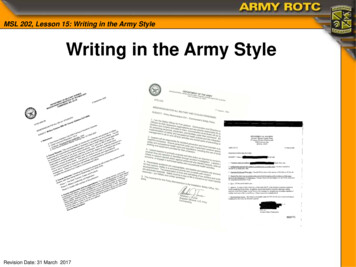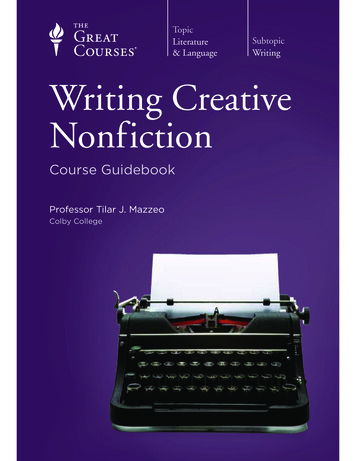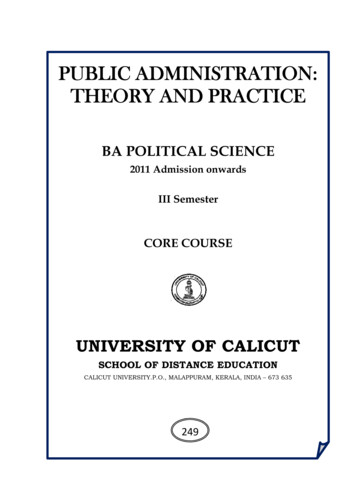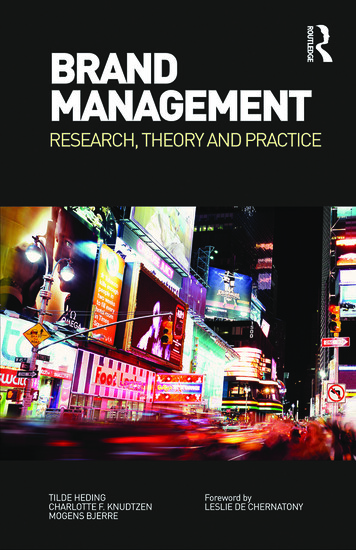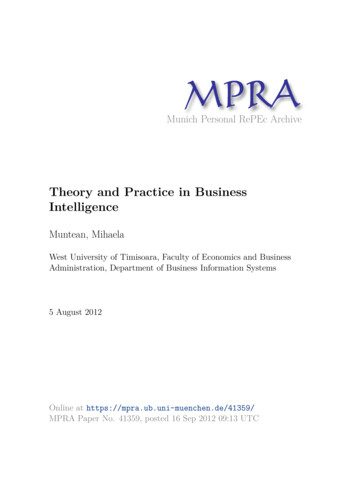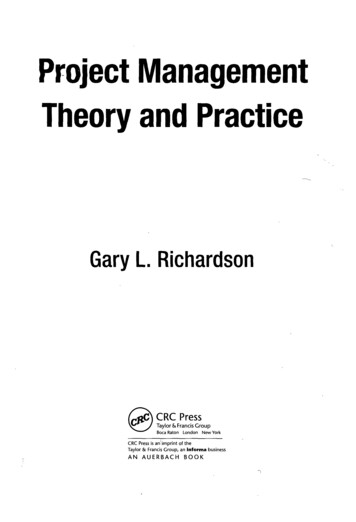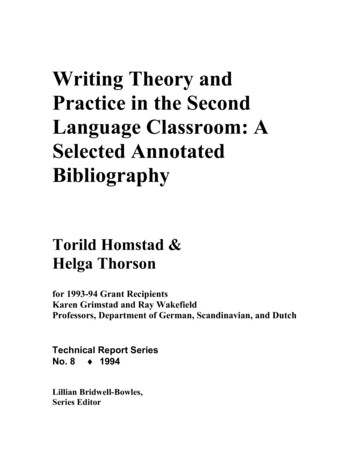
Transcription
Writing Theory andPractice in the SecondLanguage Classroom: ASelected AnnotatedBibliographyTorild Homstad &Helga Thorsonfor 1993-94 Grant RecipientsKaren Grimstad and Ray WakefieldProfessors, Department of German, Scandinavian, and DutchTechnical Report SeriesNo. 8 1994Lillian Bridwell-Bowles,Series Editor
Writing Theory andPractice in the SecondLanguage Classroom: ASelected AnnotatedBibliographyTorild Homstad &Helga Thorsonfor 1993-94 Grant RecipientsKaren Grimstad and Ray WakefieldProfessors, Department of German, Scandinavian, and DutchTechnical Report SeriesNo. 8 1994Lillian Bridwell-Bowles, Series EditorMark Olson, Editor
THE CENTER FOR INTERDISCIPLINARY STUDIES OF WRITINGUNIVERSITY OF MINNESOTA227 LIND HALL207 CHURCH STREET S.E.MINNEAPOLIS, MN 55455Director:Lillian Bridwell-Bowles, Associate Professor, EnglishResearch Assistants:Elaine Cullen, Kathleen Sheerin Devore, Michael Kuhne,Kimberly Lynch, Pamela Olano, Mark OlsonPolicy Council:Terence Collins, Professor, General College; Jeffrey Derby,Assistant Professor, Chemical Engineering, Institute ofTechnology; Emily Hoover, Associate Professor,Horticultural Science; Gerald Rinehart, Director ofUndergraduate Studies, Carlson School of Management;Ray Wakefield, Associate Professor, German,Scandinavian, and Dutch.Chris Anson, Professor, English, Director of Program inComposition and Communication; Lisa Albrecht, AssociateProfessor, General College; Robert L. Brown, AssociateProfessor, English; Ann Hill Duin, Associate Professor,Rhetoric; Donald Ross, Professor, English; Geoffrey Sirc,Associate Professor, General College; Billie Wahlstrom,Professor, Rhetoric.Faculty Affiliates:Copyright 1994 by The Board of Regents, University of MinnesotaAll Rights ReservedISBN 1-881221-17-2The University of Minnesota is committed to the policy that all personnel shall haveequal access to its programs, facilities, and employment without regard to race, color,creed, religion, national origin, sex, age, marital status, disability, public assistance status,veteran status, or sexual orientation.
PrefaceIn the 1993-94 academic year, members of the Department of German,Scandinavian, and Dutch embarked on a Center-sponsored research project investigatingthe role of writing in second language acquisition. As Torild Homstad and Helga Thorsonpoint out in their introduction to this bibliography, writing has long been considered a“support skill” for learning grammar in foreign language instruction. Their researchlooked beyond traditional writing practices in second language acquisition for newinstructional possibilities.One aspect of the project was to search current literature in composition studies,foreign language instruction, and English as a Second Language. Their annotations showthat a number of theorists and practitioners in second language instruction are pushing theboundaries of standard language instruction practices by adapting methods familiar tocomposition studies. For example, foreign language instructors are stressing the“process” approach to writing using and “writing-to-learn” strategies.Homstad and Thorson offer a particularly helpful introduction to the wide range ofopinions and practices concerning writing among foreign language instructors. For thoseengaged in foreign language and English as a Second Language instruction, thebibliography annotates articles concerned with both theoretical and practical aspects ofwriting instruction. The bibliography is also helpful for introducing composition theoristsand practitioners to new sites for thinking about literacy.The Center for Interdisciplinary Studies of Writing annually funds research projectsby University of Minnesota faculty to study any of the following topics: characteristics of writing across the University’s curriculum;
status reports on students’ writing ability at the University; the connections between writing and learning in all fields; the characteristics of writing beyond the academy; the effects of ethnicity, race, class, and gender on writing; and curricular reform through writing.We publish informal reports on the projects, such as this bibliography by Homstad andThorson, available in the form of technical reports. More elaborate reports and extendeddiscussions of Center grant recipients’ works are available through our monograph series.One of the Center’s goals is to disseminate the results of these research projects asbroadly as possible within the University community and on a national level. Weencourage discussion of Torild Homstad and Helga Thorson’s annotations andinterpretations of the literature currently available on using writing in the foreignlanguage classroom. We invite you to contact the Center for Interdisciplinary Studies ofWriting for information about other publications or Center activities.Lillian Bridwell-Bowles, Series EditorMark Olson, EditorSeptember 1994
Writing Theory and Practice in the Second Language Classroom: A SelectedAnnotated BibliographyThis annotated bibliography on second language writing provides an overview ofsome of the major ideas and resources concerning the role of writing in the secondlanguage classroom. It contains both “hands-on” material directly applicable to thelanguage classroom and articles, which trace the historical and theoretical development ofwriting pedagogy in second language education. The bibliography is part of a grantfunded by the Center for the Interdisciplinary Studies of Writing at the University ofMinnesota to investigate ways in which writing-to-learn activities can most effectively beused in the foreign language (FL) classroom.As theories of second language education have evolved from the grammartranslation to the audio-lingual method to the more communicative approaches that arecommonly used today, ideas about how language proficiency develops and ought to betaught have also changed. Writing has commonly been viewed as a support skill, used toreinforce the acquisition of grammar, as in the grammar-translation method, or to supportthe memorization of CO1TeCt language structures, as in the audio-lingual method. Untilrecently, even the communicative approaches, with their emphasis on oral proficiency,have tended to de-emphasize writing. But ideas from writing-to-learn, writing across thecurriculum, and writing for academic purposes movements in composition and English asa Second Language (ESL) have all had an impact on thinking about the place of writingin second language education.There is ample evidence to indicate the ineffectiveness of micro-correcting studentwriting in developing language competencies. More research needs to be done on how
2Homstad and Thorsonbasic second language literacy can best be developed by those who are already literate ina first language. Until we know more about how second language students learn to writecorrectly, actual classroom practices will be slow to change.Although the research on writing originally done in composition studies forms thebasis for what is happening in second language writing research, we have, for the mostpart, not included these former studies in our bibliography. Most of the current researchin second language writing has been conducted by ESL professionals; however, we alsofound many practical articles illustrating the uses of writing in FL, and ESL classrooms.We have included theoretical and historical articles so teachers can think about their ownvision of language teaching and place it in a theoretical perspective, along with “handson” articles that demonstrate effective uses of writing in actual foreign language classes.For example, a couple of authors indicate how the appropriate and creative use of wordprocessing may be a powerful tool in teaching second language writing. However, thereare also those who are still highly skeptical about the importance of writing in foreignlanguage curriculum; they are represented by three articles in this bibliography.Much exciting and important work is yet to be done in exploring the relationshipof the four modalities (listening, reading, speaking, and writing) to each other in secondlanguage acquisition, as well as determining the relationship between first and secondlanguage literacy. Our goal in preparing this annotated bibliography has been to learnmore about the theory and practice of writing pedagogy in order to make better use of itin our own teaching as well as to make these ideas and resources available to ourcolleagues. Although research on writing in second language acquisition is a relativelynew field, we found so much exciting material that it was difficult to decide where we
Writing Theory and Practice in the Second Language Classroomshould stop adding citations. We hope that our readers will find these resources equallythought-provoking and inspiring.3
4Homstad and ThorsonBibliographyAnson, Chris M., et al. Scenarios for Teaching Writing: Contexts for Discussion andReflective Practice. Urbana, Illinois: National Council of Teachers of English,1993.The authors of this book provide scenarios about various aspects of teachingwriting. Each of the scenarios highlights a specific problem or set of problems thatemerges in composition courses, focusing on both theoretical issues and practicalapplications. They are meant to provoke discussion; each scenario is followed by a set ofdiscussion questions. The authors envision this book as a catalyst for discussion ingraduate teaching seminars, workshops, and teacher training programs. The scenarios areorganized into six sections: 1) creating effective writing assignments; 2) using reading inwriting courses; 3) responding to student writing; 4) teaching grammar and style; 5)managing discourse in classes, conferences, and small groups; and 6) course designs.Although the situations have been modified, the scenarios are all “real and current” (x).They have been collected from actual events and, therefore, deal with common (yetsensitive) situations that arise in teaching writing. The scenarios vary from suspectedplagiarism to responding to content/accuracy to dealing with disruptive students andmore.Barnett, Marva A. “Writing as a Process.” The French Review 63.1 (1989): 31-44.According to Barnett, both students and teachers are commonly frustrated overthe number of errors and the lack of improvement in student writing. In this article, shelooks at how teachers traditionally assign and react to student writing. She claims thatstudents may become more involved in editing their own work if the teacher does less
Writing Theory and Practice in the Second Language Classroom5correcting. She suggests that teachers look at writing as a process, or a series of drafts,including prewriting, writing, and rewriting. Less attention to correction of grammaticalerrors, together with real attention to content, leads ultimately to better studentcompositions. Barnett claims that the advantages to both students and the teachers ofprocess writing and writing for communication include greater quantity, higher studentmotivation, and more efficient use of grading time.Brookes, Arthur, and Peter Grundy. Writing for Study Purposes: A Teacher’ s Guide toDeveloping Individual Writing Skills. Cambridge: Cambridge University Press,1990.Brookes and Grundy’s approach to teaching writing “combines communicativepractice, an integrated approach and humanistic principles.” For them, communicativelanguage features six elements: 1) having something meaningful to say, 2) reaching anaudience, 3) working in small groups, 4) working collaboratively, 5) developing registerawareness, and 6) talking naturally. The authors define humanistic principles aspromoting freedom to express one’s self, recognizing the learner as a resource, ensuringthe learner freedom from authority, valuing self-expression as intelligent, recognizing thecentrality of personal discovery, and respecting individual learning styles. Brookes andGrundy’ s book developed out of teaching “English for Academic Purposes.” As such,they have worked with more advanced language students. Exercises are long, typicallytaking thirty to fifty minutes, though many could be adapted to a much shorter time span.Almost all of the exercises are based on pair or group work, and outside evaluation isdiscouraged. Process writing is stressed—most exercises are based on the language ofargumentation, comparison and contrast, etc., rather than on solving particulargrammatical problems.
6Homstad and ThorsonBrown, Roger S. “Teaching Writing, or Cooking with Gas on the Back Burner.” DieUnterrichtspraxis 15.2 (1982): 289-292.In this article, Roger Brown discusses the role of writing in the second and thirdyear of college German courses. Although he does not go as far as John Troyanovich,who claimed that extensive writing is ineffective and “free compositions” areunproductive (see separate annotation), Brown still maintains that writing must be kept inits place. His two rules on writing in the FL classroom are 1) keep it short and 2) primestudents before they begin to write. This, according to Brown, includes providing famousquotations as models to memorize, emulating the stylistics of fables, and discussing falsecognates and deceptive pairs (e.g., das/daβ, Mal/Zeit). One technique that Brown findsparticularly productive is the “Nacherzahlung” (summary). However, he claims that anyextensive independent writing, such as free composition, should be postponed until thethird or fourth years and should be strictly limited.Although we disagree with the conclusions of this article, we find it interesting inunderstanding the resistance many foreign language teachers had (and may still have) toteaching writing in the foreign language classroom.Carson, Joan A., and Dona Leki, eds. Reading in the Composition Classroom: SecondLanguage Perspectives. Boston: Heinle and Heinle, 1993.This book examines the interrelationship of second language reading and secondlanguage writing. The first section contains articles that provide an historical backgroundas well as introduce a number of issues concerning the reading/writing relationship.Barbara Kroll’ s essay, “Teaching Writing IS Teaching Reading: Training the NewTeacher of ESL Composition,” maintains that the composition teacher must know
Writing Theory and Practice in the Second Language Classroom7theories of reading in order to successfully teach students to write. The second sectionconcerns cognitive dimensions, noting that second language research in this area is justbeginning. However, initial research suggests a correlation between reading and writingability in second language learning and the transfer of reading/writing skills acrosslanguages. Practical suggestions include establishing mediating links between studentsand the academy; devising a sequential, recursive syllabus based on reading and writing;and finding writing tasks that foster critical thinking and which maximize the students’interaction with the text. The third section is concerned with the social dimensions ofreading in the composition classroom. According to the editors, it is in the socialdimensions of literacy that pedagogical experimentation has far surpassed formalresearch.Caywood, Cynthia L., and Gillian R. Overing, eds. Teaching Writing: Pedagogy, Gender,and Equity. Albany, New York: State University of New York Press, 1987.This anthology focuses on aspects of pedagogy, the relationship between feministtheories and theories on writing, and notions of equity in the classroom. The individualauthors focus on the theoretical dimensions of gender and writing as well as providepractical suggestions for classroom activities and models for course design. Several of theauthors maintain that writing as process (rather than as product) is an essential part of anequitable classroom. The individual authors provide examples of feminist pedagogy andthe teaching of writing. These include discussions of collaborative learning (Stanger),mothering as a pedagogical model (Daumer and Runze), lowering the affective filter ofwriters (Homing), issues of equity and peace in the writing classroom (Prey), writing as amode of discovery (Quinn), and the use of journal writing (Perry), among others. Theauthors suggest ways of moving away from teacher-centered (extremely hierarchical)
8Homstad and Thorsonclassrooms to an environment that encourages equity, cooperative learning, and studentempowerment.Conrad, Lynn M., and Susan M. Goldstein. “Student Input and Negotiation of Meaning inESL Writing Conferences.” TESOL Quarterly 24.3 (1990): 443-460.In this study, Goldstein and Conrad examine the discourse used in student-teacherwriting conferences in an advanced ESL composition course and the effects thisdiscourse had on subsequent revisions of the students’ papers. In particular, the authorsare interested in the extent to which meaning is negotiated in the writing conference andthe role this negotiation plays in successful revisions of the students ‘ drafts. Goldsteinand Conrad conclude that students who negotiate meaning during the conferencedemonstrate more successful revisions, whereas students who do not negotiate meaningare more apt to make only surface-level changes. The authors maintain that writingconferences do not automatically ensure that negotiation will take place. Therefore, theysuggest that it is necessary for both students and instructors to be aware of the discourse(i.e., issues of control, importance of input and negotiation, etc.) that takes place in thewriting conference. For example, they suggest that instructors should videotapethemselves during a writing conference in order to understand the complex workings ofdiscourse. Instructors should also explicitly teach techniques for contributing input andnegotiating meaning so that students can get the most out of their writing conferences.Dvorak, Trisha. “Writing in the Foreign Language.” Listening, Reading, and Writing:Analysis and Application. Ed. Barbara H. Wing. Middlebury, Vermont: NortheastConference on the Teaching of Foreign Languages, 1986. 145-167.After defining what “writing” is, Dvorak begins her article with an historicalsummary of views on learning to write in a foreign language. She maintains that with theshift towards audiolingualism, oral language took precedence in the classroom over all
Writing Theory and Practice in the Second Language Classroom9other modalities. Writing, when it was used, was mainly for purposes of transcription.Even with the current shift towards a more communicative view of language, writing isstill not emphasized in most foreign language classes. Dvorak claims that foreignlanguage textbooks in the last twenty-five years have linked written composition toadvanced grammar or to conversation—rather than focusing on compositional skills suchas organization, clarity, and manipulating various functions (i.e., describing, informing,persuading). Dvorak also discusses the difference between written and spoken language,the relationship between writing in a first language and writing in a second language,how writing fits into Krashen’s language acquisition/learning model, and writing as adevelopmental process.Dvorak draws two important conclusions about writing in a foreign language: 1)“writing improvements are unrelated to grammar study,” and 2) “intensive correction ofstudent writing, which has a negative effect on writing in terms of student attitudes andmotivation, has little positive effect at all” (151-152). Dvorak’s final section on“Implications for Program Design and Classroom Methodology” is particularly useful.Dvorak discusses the process approach to writing, the instructor’s role as reader ratherthan judge, and how to integrate writing into the foreign language program as a whole.Eisterhold, Joan Carson. “Reading-Writing Connection: Towards a Description forSecond Language Learners.” Second Language Writing: Research Insights for theClassroom. Ed. Barbara Kroll. Cambridge Applied Linguistics. Cambridge:Cambridge University Press, 1990. 88-101.According to Eisterhold, the relationship between first language reading andwriting indicates that better writers tend to be better readers, better writers read more thanpoorer writers, and better readers produce more syntactically mature writing than poorerreaders. The question in second language learning is in which direction the skills are
10Homstad and Thorsonbeing transferred. The most obvious model is from reading to writing, although somestudies show that writing activities can be useful for improving reading comprehensionand retention of information, in particular. In this directional model, skills acquired inone modality can be transferred to the other. It appears, though, that this transfer is notautomatic, but only comes as a result of direct instruction. Another hypothesis maintainsthat the link between reading and writing is nondirectional and results from a singleunderlying proficiency, the cognitive process of constructing meaning. The bidirectionalhypothesis claims that reading and writing are interactive, but also independent. Each ofthese models indicates a different relationship between the development of reading andwriting skills, and invites different classroom approaches to the teaching of reading andwriting. This issue is further complicated when we consider the second language learnerwho is already literate in a first language. Evidence suggests that after a certain thresholdof language proficiency has been attained, first language literacy may have a positiveeffect on the development of second language skills. However, research also indicatesthat this transfer of skills is not automatic. Teachers can help their students use their firstlanguage skills in learning a second language by making clear the interrelationshipbetween reading and writing in both the first and the target language.Gaudiani, Claire. Teaching Writing in the Foreign Language Curriculum. Washington,D.C.: Center for Applied Linguistics, 1981.This is one of the first comprehensive studies on writing in the foreign languageclassroom. Gaudiani’s monograph is divided into three sections. In the main section sheprovides a detailed summary of how she treats writing in her French compositioncourses; in the second section she discusses the importance of writing across thecurriculum; and in the final section (appendix) she provides syllabi, exams, handouts,
Writing Theory and Practice in the Second Language Classroom11sample student texts, and sample evaluations. Her text as a whole is informative andpractical. In her introduction she provides much helpful advice on how to treat writing inthe FL classroom. She notes, for example, the importance of teachers writing with theirstudents, the need to build common goals from the very beginning, and the use of theforeign language in the class. She also discusses the difference between writing in anative language and a foreign language. In the main part of her monograph Gaudianiprovides a “hands-on” description of her composition classes including a list ofcomposition topics, the philosophy behind the classroom dynamics (i.e., the class as ateam), the group editing process (which focuses not only on comprehension andaccuracy, but also prose style, organization, and synthesis), and the evaluation of studentpapers. During the second half of the semester, Guadiani begins to put more focus onprose style and has her students write “pastiches.” She describes all of her assignments ingreat detail and shows how she treats vocabulary, grammar, and style analysis in herclassroom. Besides weekly essay writing and re-writing, Guadiani also has her studentskeep a journal throughout the semester. Guadiani discusses writing across the curriculumand the need to demonstrate the important of writing in all subject areas. The detailedsuggestions she provides for teaching writing in the classroom are the most helpfulelement of the monograph. Besides the packet of handouts she provides, she also includesa helpful list of suggestions to teachers to cut down on the paperwork and the time spentcorrecting student papers.Gaudiani, Claire. “Teaching Writing in the Foreign Language Curriculum. “ Strategiesfor the Development of Foreign Language and Literature Programs. Ed. ClaireGaudiani. New York: Modern Language Association of America, 1984. 151-171.
12Homstad and ThorsonGaudiani’ s chapter on writing in the FL classroom in her book Strategies for theDevelopment of Foreign Language & Literature Programs is a shortened adaptation ofher earlier study (1981) described in the entry above.Gere, Anne Ruggles, ed. Roots in the Sawdust: Writing to Learn across the Disciplines.Urbana, Illinois: National Council of Teachers of English, 1985.This book consists of articles from the Puget Sound Writing Program (a site of theNational Writing Project) on writing-to-learn strategies. The book is more practical thantheoretical and focuses on the implementation of writing-to-learn activities in the highschool curriculum. Based on the belief that writing is a means of learning, the articles inthis book suggest writing-to-learn techniques in a wide range of subject areas. Theseareas include literature, art, foreign languages, social studies, special education, science,math, philosophy, and history. Besides these content-specific articles, there are generalarticles on the connections between writing and thinking, the benefits of the coursejournal, and student comments on writing-to-learn activities. The glossary is especiallyhelpful; it describes everything from Admit Slips to Writing Groups and providesinstructors with practical suggestions and tools for using writing-to-learn strategies in theclassroom. As all of these articles point out, writing-to-learn activities help studentsunderstand and engage in course material, help students think, and illustrate the variousstages in the process of writing.Greenia, George. “Computers and Teaching Composition in a Foreign Language.”Foreign Language Annals 25.1 (1992): 33-46.The grammar/composition course is, according to Greenia, usually one of themost traditional courses in the foreign language curricula. In this article, he suggests howusing computers can restructure the composition course in positive ways for both the
Writing Theory and Practice in the Second Language Classroom13teacher and the student Greenia begins by providing an overview of the current researchon writing in the foreign language classroom. He then describes how he used computersin his Spanish composition course. Students were asked to carry out various kinds ofwriting tasks on the computer (i.e., essays, homework, peer reviews, dialogue journals,private journals, and an open bulletin board to encourage communication and interactionamong students. Greenia maintains that using the computer in the composition classroomallows students to write more frequently, without increasing the instructor’s work loadHe describes in great detail how he implemented computer technology into his class andsome of the potential problems and ethical issues that arise with this new form oftechnology. Greenia’ s article suggests that computers force language teachers to rethinkwhat the foreign language course should look like and help us move away from a teachercentered classroom towards a communicative community of language learners. Wehighly recommend this article to anyone who is thinking about using computers in the FLclassroom.Greenia, George D. “Why Johnny Can’t Escribir: Composition and the ForeignLanguage Curriculum.” ADFL Bulletin 24.1 (1992): 30-37.Answering the question “why Johnny can’t escribir,” Greenia writes: “Johnnycan’t escribir because we have not trained him to” (30). Greenia maintains that theintermediate-or advanced-level writing classes for foreign language students usually donot concentrate on writing. Composition courses end up as either as topics course (i.e.,focusing on literature or civilization) or as a grammar course. Greenia provides a list ofguidelines that gives writing the attention it deserves in the foreign the languagecurriculum:
14Homstad and Thorson1) “The writing course should have its own place in the curriculum, but it should notstand alone as the sole undergraduate writing experience in the second language”(31);2) “Writing in the foreign language in itself has not proved an effective vehicle forlearning grammar.” (33);3) “A foreign language writing course is a valuable language course in and of itself;it is not a service course to prepare students for something else” (33);4) “Second-language writing should not be conceived of as primarily a literaturecourse in another form.” (34);5) “A focus on writing for exchanging and engaging ideas puts students with varyinglanguage strengths on a more nearly equal footing.” (35);6) “All discourse generated in a writing class should be public rather than private”(35); and7) “A well-developed oral component can enliven the initial exchange of ideas, helpdefine topics. and generally serve as a platform for prewriting activities” (36).Greenia’ s article summaries the recent research and theory on writing in the foreignlanguages, discusses process writing using peer review and coediting, and provides cleargoals for developing writing skills in the foreign language composition course. Anotherinteresting aspect of Greenia’s article is his brief discussion of the so-called gap betweenthe beginning language program and third-year composition courses.Hamp-Lyons, Liz, ed. Assessing Second Language Writing in Academic Contexts.Writing Research: Multidisciplinary Inquiries into the Nature of Writing Ser.Norwood. New Jersey: Ablex Publishing Corporation, 1991.
Writing Theory and Practice in the Second Language Classroom15This volume, part of the Writing Research Series, focuses on second languagewriting assessment. The individual authors dis
centrality of personal discovery, and respecting individual learning styles. Brookes and Grundy’ s book developed out of teaching “English for Academic Purposes.” As such, they have worked with more advanced language students. Exercises are long, typically taking thirty to fifty minutes
